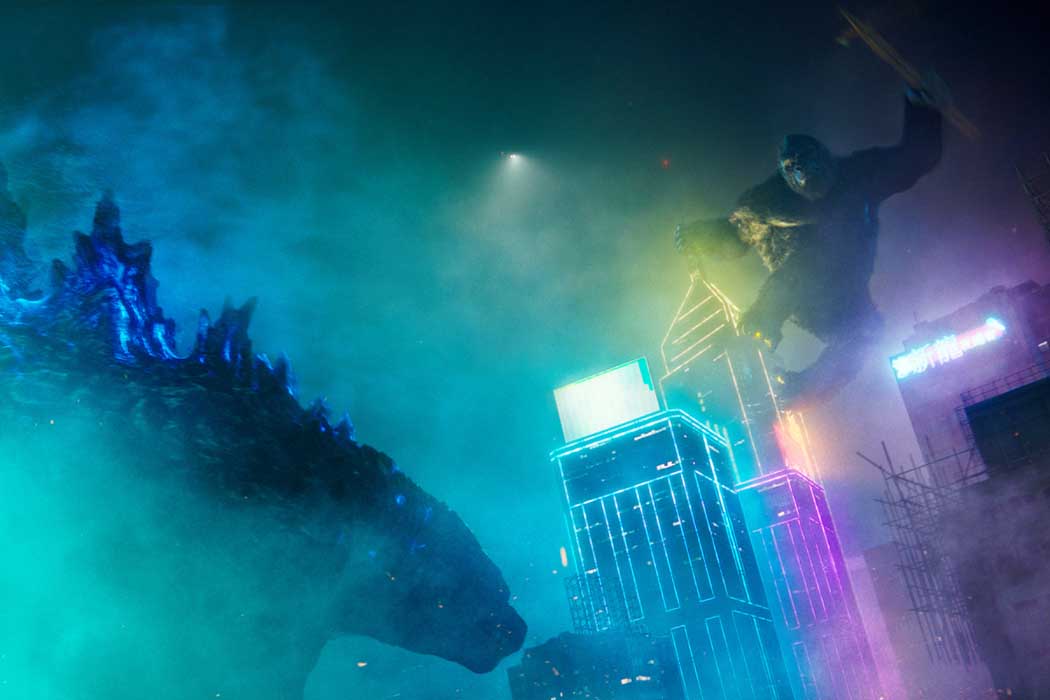When it comes to monster movies, the bigger the better. The monsters should be huge, the action fantastic, the budgets sky-high, and the melodrama immeasurable. Godzilla vs. Kong steps into the colossal shadow cast by the cinematic history of both titular creatures, and leaves its own gargantuan mark on the franchises.
Taking the helm to direct this latest installment is Adam Wingard, who began his career working on micro-budget indie horror. While that might not seem like the typical training for a kaiju blockbuster director, the path from horror to Godzilla is well-trodden. Godzilla (2014) was directed by Gareth Edwards, who cut his teeth on Monster, and Michael Dougherty directed Trick ‘r Treat before he took on Godzilla: King of the Monsters. Both films had their own unique strengths and weaknesses, but as directors, Edwards and Dougherty walked so that Wingard could run.
Godzilla has been portrayed in 36 movies over the past 67 years, alternately appearing as an ancient creature and a new, nuclear-era phenomenon. In Godzilla vs. Kong, he’s mad as hell—and leaving a path of destruction everywhere he goes.
This time around, though, Kong (who seems to have dropped King from his title several movies ago) is the emotional center and clear star of the film. The movie opens with the giant gorilla having a lazy morning, going for a walk set to easy rock and roll. The primate is graying but still physically imposing, perhaps even more since we last saw him in Kong: Skull Island. This calm morning is a ruse, though, and Kong knows it. Like a jungle-themed The Truman Show, Kong’s home is an ersatz habitat, and he is trapped under the scrutiny of scientists and the military as a means to control and protect. Researcher Irene (Rebecca Hall) knows Kong best, and her adopted daughter Jia (Kaylee Hottle) has a special bond with the big ape.
Never one to let another creature grab too much screen time, Godzilla breaks the idyll by launching into a seemingly unprovoked attack. Apex Cybernetics is possibly up to no good, which may or may not be linked to the Godzilla attack that came out of nowhere. Low-level employee Bernie (Brian Tyree Henry) escapes by the skin of his teeth and is determined to get to the bottom of it. (Bernie provides comic relief throughout the film, making the most of being a hilarious addition to a largely humorless script.)
Within 10 minutes of the film’s start, we know both the creatures and the plot. The swiftness of the setup is important in Godzilla vs. Kong because it confirms an understanding of why audiences want to see a monster matchup like this in the first place—it’s not for the human drama. At their best, monster movie plots are a thin frame around which all of the fantastical action can revolve. This is not to say that a bad performance or a ludicrous plot cannot run a fun clash of colossi, but those flicks quickly lose focus. Godzilla vs. Kong understands that, and uses the monsters to drive the plot.
Godzilla vs. Kong revels in the spectacle, taking us to incredible worlds with ancient flying creatures, gravity-reversed underworlds, and laboratory bunkers buried miles below the Earth’s surface to conceal top secret experiments. And we get to see plenty of monster fights.
Unlike Godzilla (2014), the film is not trying to build up to a massive showdown between behemoths. We watch them match up and go for the win many times—at sea and in the city. The CGI for these creatures and their surroundings looks marvelous, and is enhanced by equally deft sound design. Never are the maneuvers of the battle lost in confusion of bad editing or inexplicably tight framing. It is all there in its indulgent, escapist glory.
